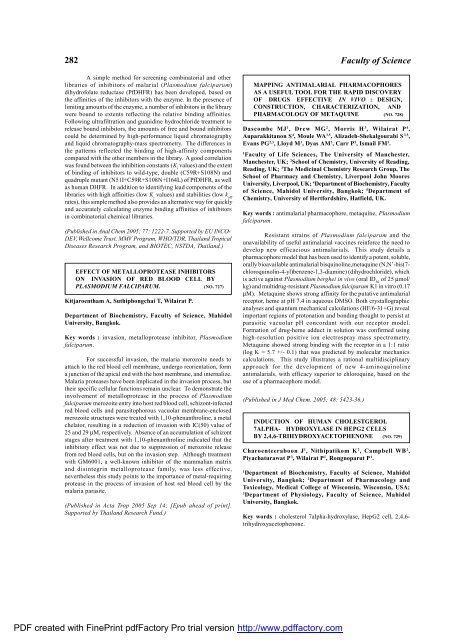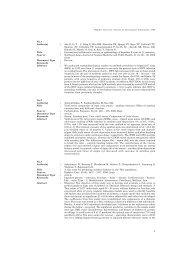Faculty of Science - Mahidol University
Faculty of Science - Mahidol University
Faculty of Science - Mahidol University
You also want an ePaper? Increase the reach of your titles
YUMPU automatically turns print PDFs into web optimized ePapers that Google loves.
282<br />
A simple method for screening combinatorial and other<br />
libraries <strong>of</strong> inhibitors <strong>of</strong> malarial (Plasmodium falciparum)<br />
dihydr<strong>of</strong>olate reductase (PfDHFR) has been developed, based on<br />
the affinities <strong>of</strong> the inhibitors with the enzyme. In the presence <strong>of</strong><br />
limiting amounts <strong>of</strong> the enzyme, a number <strong>of</strong> inhibitors in the library<br />
were bound to extents reflecting the relative binding affinities.<br />
Following ultrafiltration and guanidine hydrochloride treatment to<br />
release bound inhibitors, the amounts <strong>of</strong> free and bound inhibitors<br />
could be determined by high-performance liquid chromatography<br />
and liquid chromatography-mass spectrometry. The differences in<br />
the patterns reflected the binding <strong>of</strong> high-affinity components<br />
compared with the other members in the library. A good correlation<br />
was found between the inhibition constants (K i values) and the extent<br />
<strong>of</strong> binding <strong>of</strong> inhibitors to wild-type, double (C59R+S108N) and<br />
quadruple mutant (N51I+C59R+S108N+I164L) <strong>of</strong> PfDHFR, as well<br />
as human DHFR. In addition to identifying lead components <strong>of</strong> the<br />
libraries with high affinities (low K i values) and stabilities (low k <strong>of</strong>f<br />
rates), this simple method also provides an alternative way for quickly<br />
and accurately calculating enzyme binding affinities <strong>of</strong> inhibitors<br />
in combinatorial chemical libraries.<br />
(Published in Anal Chem 2005; 77: 1222-7. Supported by EU INCO-<br />
DEV, Wellcome Trust, MMV Program, WHO/TDR, Thailand Tropical<br />
Diseases Research Program, and BIOTEC, NSTDA, Thailand.)<br />
EFFECT OF METALLOPROTEASE INHIBITORS<br />
ON INVASION OF RED BLOOD CELL BY<br />
PLASMODIUM FALCIPARUM. (NO. 727)<br />
Kitjaroentham A, Suthiphongchai T, Wilairat P.<br />
Department <strong>of</strong> Biochemistry, <strong>Faculty</strong> <strong>of</strong> <strong>Science</strong>, <strong>Mahidol</strong><br />
<strong>University</strong>, Bangkok.<br />
Key words : invasion, metalloprotease inhibitor, Plasmodium<br />
falciparum.<br />
For successful invasion, the malaria merozoite needs to<br />
attach to the red blood cell membrane, undergo reorientation, form<br />
a junction <strong>of</strong> the apical end with the host membrane, and internalize.<br />
Malaria proteases have been implicated in the invasion process, but<br />
their specific cellular functions remain unclear. To demonstrate the<br />
involvement <strong>of</strong> metalloprotease in the process <strong>of</strong> Plasmodium<br />
falciparum merozoite entry into host red blood cell, schizont-infected<br />
red blood cells and parasitophorous vacuolar membrane-enclosed<br />
merozoite structures were treated with 1,10-phenanthroline, a metal<br />
chelator, resulting in a reduction <strong>of</strong> invasion with IC(50) value <strong>of</strong><br />
25 and 29 μM, respectively. Absence <strong>of</strong> an accumulation <strong>of</strong> schizont<br />
stages after treatment with 1,10-phenanthroline indicated that the<br />
inhibitory effect was not due to suppression <strong>of</strong> merozoite release<br />
from red blood cells, but on the invasion step. Although treatment<br />
with GM6001, a well-known inhibitor <strong>of</strong> the mammalian matrix<br />
and disintegrin metalloprotease family, was less effective,<br />
nevertheless this study points to the importance <strong>of</strong> metal-requiring<br />
protease in the process <strong>of</strong> invasion <strong>of</strong> host red blood cell by the<br />
malaria parasite.<br />
(Published in Acta Trop 2005 Sep 14; [Epub ahead <strong>of</strong> print].<br />
Supported by Thailand Research Fund.)<br />
MAPPING ANTIMALARIAL PHARMACOPHORES<br />
AS A USEFUL TOOL FOR THE RAPID DISCOVERY<br />
OF DRUGS EFFECTIVE IN VIVO : DESIGN,<br />
CONSTRUCTION, CHARACTERIZATION, AND<br />
PHARMACOLOGY OF METAQUINE (NO. 728)<br />
Dascombe MJ 1 , Drew MG 2 , Morris H 3 , Wilairat P 4 ,<br />
Auparakkitanon S 4 , Moule WA 3,5 , Alizadeh-Shekalgourabi S 3,5 ,<br />
Evans PG 2,3 , Lloyd M 3 , Dyas AM 3 , Carr P 5 , Ismail FM 3 .<br />
1 <strong>Faculty</strong> <strong>of</strong> Life <strong>Science</strong>s, The <strong>University</strong> <strong>of</strong> Manchester,<br />
Manchester, UK; 2 School <strong>of</strong> Chemistry, <strong>University</strong> <strong>of</strong> Reading,<br />
Reading, UK; 3 The Medicinal Chemistry Research Group, The<br />
School <strong>of</strong> Pharmacy and Chemistry, Liverpool John Moores<br />
<strong>University</strong>, Liverpool, UK; 4 Department <strong>of</strong> Biochemistry, <strong>Faculty</strong><br />
<strong>of</strong> <strong>Science</strong>, <strong>Mahidol</strong> <strong>University</strong>, Bangkok; 5 Department <strong>of</strong><br />
Chemistry, <strong>University</strong> <strong>of</strong> Hertfordshire, Hatfield, UK.<br />
Key words : antimalarial pharmacophore, metaquine, Plasmodium<br />
falciparum.<br />
Resistant strains <strong>of</strong> Plasmodium falciparum and the<br />
unavailability <strong>of</strong> useful antimalarial vaccines reinforce the need to<br />
develop new efficacious antimalarials. This study details a<br />
pharmacophore model that has been used to identify a potent, soluble,<br />
orally bioavailable antimalarial bisquinoline,metaquine (N,N’-bis(7chloroquinolin-4-yl)benzene-1,3-diamine)<br />
(dihydrochloride), which<br />
is active against Plasmodium berghei in vivo (oral ID 50 <strong>of</strong> 25 μmol/<br />
kg) and multidrug-resistant Plasmodium falciparum K1 in vitro (0.17<br />
μM). Metaquine shows strong affinity for the putative antimalarial<br />
receptor, heme at pH 7.4 in aqueous DMSO. Both crystallographic<br />
analyses and quantum mechanical calculations (HF/6-31+G) reveal<br />
important regions <strong>of</strong> protonation and bonding thought to persist at<br />
parasitic vacuolar pH concordant with our receptor model.<br />
Formation <strong>of</strong> drug-heme adduct in solution was confirmed using<br />
high-resolution positive ion electrospray mass spectrometry.<br />
Metaquine showed strong binding with the receptor in a 1:1 ratio<br />
(log K = 5.7 +/- 0.1) that was predicted by molecular mechanics<br />
calculations. This study illustrates a rational multidisciplinary<br />
approach for the development <strong>of</strong> new 4-aminoquinoline<br />
antimalarials, with efficacy superior to chloroquine, based on the<br />
use <strong>of</strong> a pharmacophore model.<br />
(Published in J Med Chem. 2005; 48: 5423-36.)<br />
INDUCTION OF HUMAN CHOLESTGEROL<br />
7ALPHA- HYDROXYLASE IN HEPG2 CELLS<br />
BY 2,4,6-TRIHYDROXYACETOPHENONE (NO. 729)<br />
Charoenteeraboon J 1 , Nithipatikom K 2 , Campbell WB 2 ,<br />
Piyachaturawat P 3 , Wilairat P 1 , Rongnoparut P 1 .<br />
1 Department <strong>of</strong> Biochemistry, <strong>Faculty</strong> <strong>of</strong> <strong>Science</strong>, <strong>Mahidol</strong><br />
<strong>University</strong>, Bangkok; 2 Department <strong>of</strong> Pharmacology and<br />
Toxicology, Medical College <strong>of</strong> Wisconsin, Wisconsin, USA;<br />
3 Department <strong>of</strong> Physiology, <strong>Faculty</strong> <strong>of</strong> <strong>Science</strong>, <strong>Mahidol</strong><br />
<strong>University</strong>, Bangkok.<br />
<strong>Faculty</strong> <strong>of</strong> <strong>Science</strong><br />
Key words : cholesterol 7alpha-hydroxylase, HepG2 cell, 2,4,6trihydroxyacetophenone.<br />
PDF created with FinePrint pdfFactory Pro trial version http://www.pdffactory.com
















